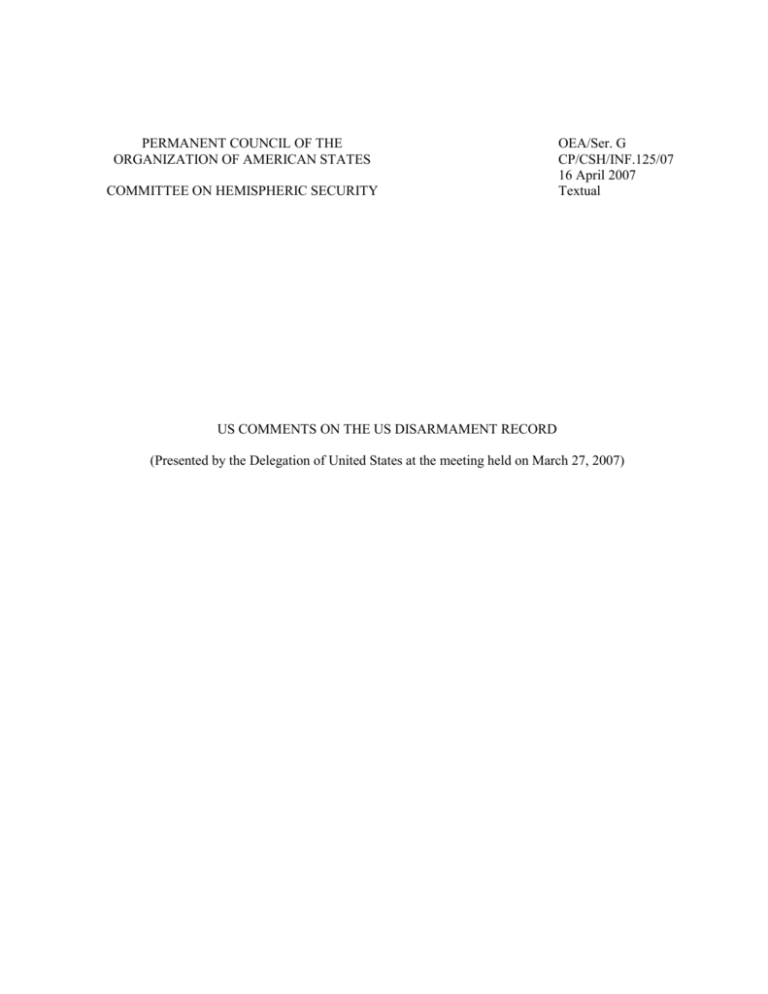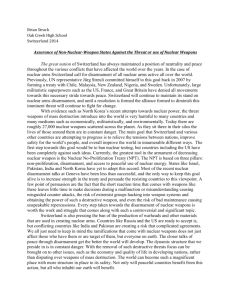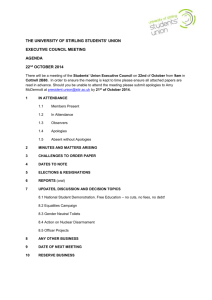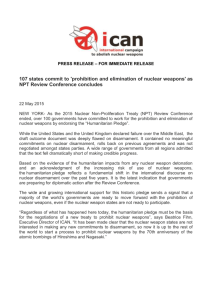Draft 2/16/07 - Department of Conferences and Meetings Management
advertisement

PERMANENT COUNCIL OF THE ORGANIZATION OF AMERICAN STATES COMMITTEE ON HEMISPHERIC SECURITY OEA/Ser. G CP/CSH/INF.125/07 16 April 2007 Textual US COMMENTS ON THE US DISARMAMENT RECORD (Presented by the Delegation of United States at the meeting held on March 27, 2007) US COMMENTS ON THE US DISARMAMENT RECORD (Presented by the Delegation of United States at the meeting held on March 27, 2007) Thank you. I have asked for the floor to set the record straight and respond to several allegations made against the United States during the presentations by civil society organizations during the March 15 Committee on Hemispheric Security meeting. The U.S. is compliant with our disarmament obligations under the Nuclear Nonproliferation Treaty (NPT) and we have a proven record of performance in moving toward the fulfillment of the disarmament goals expressed in the Preamble and Article VI of the Treaty. Our history and accomplishments with respect to disarmament are a matter of public record. The U.S. values engagement and dialogue about disarmament. We are committed to encouraging and engaging in open and honest debate about disarmament in order to make sure that the reality of our record and our policy is clear. In order to help convey these facts, explain our positions and perspectives, and catalyze constructive debate about disarmament, the United States recently released a series of important papers on disarmament issues as part of our preparation for the upcoming NPT Preparatory Committee meeting in Vienna. These papers have been posted on the Department of State’s website and can be found at the following web-link http://www.state.gov/t/isn/wmd/nnp/c21893.htm. There is not enough time this afternoon to recount the details of these U.S. position papers, but let me mention a few highlights of the U.S. record of disarmament achievements. The United States has eliminated more than 13,000 nuclear weapons since 1988 and gotten rid of more than 1,000 ballistic missiles and 450 missile silos. But this process is not over. The Bush Administration dismantled the last W-56 warhead for the Minuteman II missile in June 2006, and it has requested significant increases in the current budget for nuclear warhead dismantlement. We are currently in the process of drawing down our strategic warhead numbers in order to meet Moscow Treaty targets. When we have completed this task, our nuclear arsenal will be at about a quarter of its size at the end of the Cold War, and will have reached its lowest level since the Eisenhower Administration. The Bush Administration has also continued longstanding -2reductions in delivery systems, and we recently announced that we would eliminate about 400 Advanced Cruise Missiles currently deployed with the B-52 bomber fleet. We have not produced any uranium for use in nuclear weapons since 1964, nor any plutonium for such purposes since 1988, and we have scrupulously observed the nuclear testing moratorium we announced in 1992. We have also been actively removing fissile material from our nuclear weapons programs, placing some of it under International Atomic Energy Agency (IAEA) safeguards, and down-blending some 90 tons of highly-enriched uranium (HEU) from defense nuclear programs for use in civilian power reactors. The most recent step in this process occurred as recently as November 2005, when the Bush Administration announced that it would remove another 200 metric tons of HEU from any further use as fissile material in U.S. nuclear warheads. This is enough material, according to IAEA figures, to make 8,000 nuclear weapons. Meanwhile, the United States in May 2006 became the first (and so far only) country to introduce a draft Fissile Material Cutoff Treaty (FMCT) at the U.N. Conference on Disarmament. The United States is also beginning development of the Reliable Replacement Warhead (RRW), which will help us to continue to meet our deterrence needs until the total elimination of nuclear weapons can be achieved, but to do so with safer warheads, fewer warheads, and less potential need to resume nuclear testing. The RRW, which adds no new nuclear weapons capabilities, thus supports and will help advance the disarmament objectives of the NPT. For those of you who fear that the United States may nonetheless be increasing its reliance upon nuclear weapons, rest assured that this is false. Indeed, pursuant to our Nuclear Posture Review (NPR) of 2001, the United States is reducing its formerly exclusive reliance upon nuclear weapons for strategic deterrence. In place of the exclusively nuclear strategic “Triad” of the Cold War, the United States relies increasingly on a combination of non-nuclear offensive strike capabilities, active and passive defenses (including ballistic missile defenses), and a robust and responsive defense industrial infrastructure to satisfy the requirements of strategic deterrence with a lessened emphasis on nuclear weapons. The Strategic Arms Reduction Treaty (START I) will expire in 2009, and the Moscow Treaty in 2012. We have already begun high-level discussions with the Russians about what our future strategic security relationship should look like. It is too early to say much about those -3talks, but we hope that transparency and confidence-building measures remain an enduring part of the U.S.-Russia relationship as it continues to mature in a post-Cold War environment. The United States, therefore, has an unsurpassed record of disarmament achievements – and its progress toward fulfilling the goals of the NPT’s Preamble and Article VI continues today as a high priority. We have emphatically and repeatedly reaffirmed our commitment to these goals, and we do so again today. But disarmament is not a question merely for the United States, nor even for the five NPT Nuclear Weapons States together. As the Treaty’s Preamble makes clear, the critical ingredient for real success in achieving the NPT’s goals is the contribution of all states to easing tension and strengthening trust between nations in order to create not only a world in which it will be possible to achieve the total elimination of nuclear weapons but also one in which it will be possible to sustain that elimination over time. To achieve this will require much more realistic and practical thinking about and planning for disarmament than has hitherto occurred in international diplomatic circles. As a contribution to helping the international community think realistically about how to achieve these goals, the recent U.S. papers break new ground in setting forth our thinking about what the global security environment might need to look like if it were to become both possible and realistic to achieve the elimination of nuclear weapons. One paper, for instance, suggests six factors that are likely to be necessary if achieving and sustaining a nuclear disarmament regime is to become a practical reality rather than merely a utopian fantasy. In the fourth paper, the United States offers some suggestions about how to help move today’s global security environment in the direction of total nuclear disarmament. We invite discussion and debate on this topic with our international partners, for it is very important for states continuously to evaluate what measures and approaches will contribute to achieving the goals of the NPT’s Preamble and Article VI. Not everything that has in the past seemed to be a good idea in contributing to the achievement of disarmament goals will always remain the best guidepost for fulfilling these objectives in today’s world. And not everything upon which we may agree today will remain relevant tomorrow. They key is to engage in ongoing debate and dialogue on these matters, and identify the things that will do the most to move our current world in the direction it needs to go if total nuclear disarmament is to become possible and sustainable. -4To that end, the United States has offered a number of suggestions about how to help update international thinking and build upon the lessons of recent experience in order to facilitate real movement toward the NPT’s objectives. If the total elimination of nuclear weapons is to be achieved – and the United States very much hopes that it will be – this will come about not through wishful thinking or naïve assumptions that the only thing needed is for the nuclear weapons states to wake up one morning with a different perspective. Achieving nuclear disarmament will require much thought, hard work, and tough decisions by all participants in the international arena. Among other things, it will require: efforts by key regional players to build an environment increasingly free of the tensions that make disarmament progress more difficult; uniform and sustained success in enforcing nonproliferation obligations and in preventing the emergence of regional nuclear arms races of the sort that could be caused if Iran’s nuclear weapons program is not stopped or North Korea’s nuclear weapons not eliminated; steadfast efforts by nuclear weapons states to decrease reliance upon nuclear weapons as the United States is doing; and serious planning for how to use non-nuclear means to meet any deterrent requirements that survive into a world divested of nuclear weapons; and hard work to create a world in which any country contemplating “breakout” of a disarmament regime will know that it is unlikely to realize strategic gains from such a violation and in fact will suffer costs disproportionate to any benefit that might be expected. The United States invites discussion of all these issues during this new NPT review cycle, in order to raise the caliber of debate on disarmament topics and thus contribute to building a world in which the elimination of nuclear weapons ceases to be merely a daydream and instead can become a practical and sustainable reality. CP18111T01





